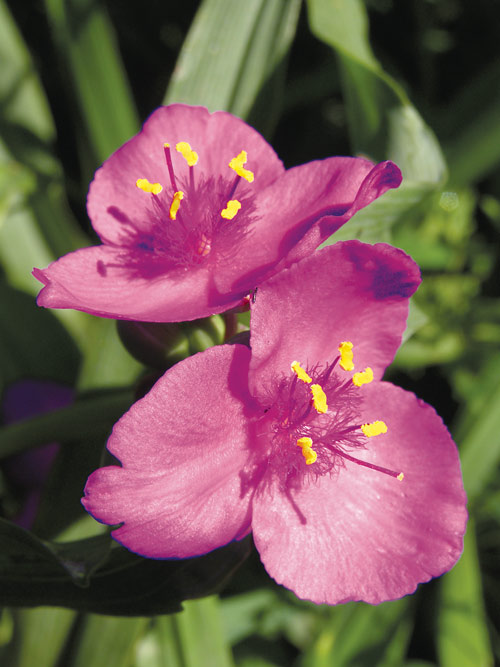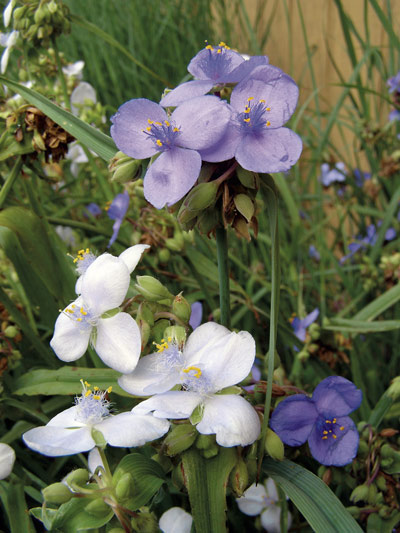Spiderworts’ many colors “curiously lurking amongst the grassâ€
Originally published June 12, 2008

Rosy color variation of blue spiderwort. Note how the slender female pistil is remaing aloof from her six stamen brothers. That encourages healthy cross pollination! Photo by Ken Moore
By Ken Moore
In spite of the early heat wave, cool shades of spiderwort flowers continue to cheer up the early morning hours. The one moving around my yard is most likely Tradescantia ohiensis, Smooth Spiderwort, with leaves having a somewhat whitish cast (glaucous) to them. The pair of leaves immediately below the flower clusters are as wide as the stem leaves.
The name Tradescantia honors the two John Tradescants, father and son, of England. King Charles I sent John Tradescant the younger, to Virginia in 1637 to gather all rarities of flowers, plants and shells. By that date, John Tradescant the elder, the king’s gardener, was already growing many American plants in his London garden. Spiderworts were one of the earliest American plants transported back to England.
Legendary English personality, writer and gardener Vita Sackville-West describes spiderwort as “another plant I like very much, sometimes called the Trinity Flower, owing to its three petals of a rich violet, curiously lurking amongst the grassy leaves.â€
I love the notion of flowers “curiously lurking amongst the grassy leaves,†and that’s exactly how I find them these early mornings. I don’t remember when I may have planted one in a flower bed when I used to try being organized about gardening. Happily, they freely self-seed so that I have them now in sun and shade and I don’t have to water where they plant themselves. When they seem to have finished flowering and flop over as the real heat of the summer comes on, I simply cut the stems back and enjoy another flush of growth and flowering if ample rainfall makes that an option.
My real admiration for the plant is the endless palette of blue and violet shades that appear from the self-sowing plants. No two are ever quite alike, and often one finds some really special colors. A rosy red-color form was “curiously lurking†in amongst many blues at the edge of my porch steps a couple of weeks ago. For the hard-core Tar Heel fan who also gardens, there are some Carolina Blue color forms of spiderwort lurking amongst all the others in a showy bed behind the Totten Center of the Botanical Garden. That Carolina Blue spiderwort (my name for it) has been in that bed for several years. Perhaps the garden staff will someday propagate and offer for sale Tradescantia “Tar Heel Blue.â€
Spiderwort’s Native American heritage includes eating young plants as greens in the spring; however, the oozy, sticky sap of a broken spiderwort stem makes such an idea unappealing to me. Root teas were considered effective for stomach ailments and root poultices were considered an effective cancer cure. I particularly like the description of spiderwort as one of the ingredients in a medicine for kidney troubles, “requiring an accompanying prayer.†A prayer is probably a wise necessity with any herbal remedy.
Lack of medical expertise guides me in keeping my spiderworts out of the medicine cabinet and encouraging them to “curiously lurk†anywhere they can sustain themselves in my landscape.

A Carolina Blue form of Spiderwort Lurking with the common blues at the Botanical Garden. Photo by Ken Moore


Trackbacks and Pingbacks
Comments are closed.